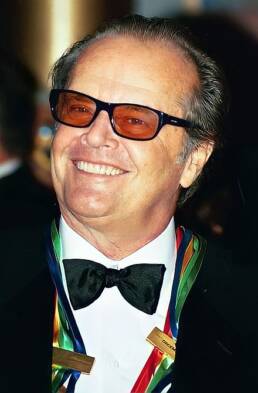These life stories may contain descriptions of childhood trauma and abuse, as well as images, voices and names of people now deceased. If you need help, you can find contact details for some relevant support services on our support page.
American actor, Jack Nicholson (b. 1937), was in kinship care as a child.
John Joseph Nicholson was left by his seventeen-year mother, June, with his grandparents, Ethel May Nicholson (a hairdresser who was in foster care from the age of six) and John Joseph Nicolson (a department store window dresser and adoptee). He was raised in Neptune City, New Jersey believing his grandparents were his parents.
Ethel May told everybody she was Jack’s mother. She filed a birth certificate, in 1954, when Jack was of driving age and needed identification papers before heading to California…
Although many people harbored suspicions about Ethel May’s ‘son,’ only one other person besides the three Nicholson women [Ethel May, June, and June’s sister, Lorraine] could have known, for certain, that Ethel May was not Jack’s mother. This was John J., the putative father (McGilligan 35).
Nicholson did not find out that his ‘sister’ June was his mother until long after her death from cancer in 1963. A Time Magazine journalist confronted him with the facts in 1974.
“I’d say it was a pretty dramatic event, but it wasn’t what I’d call traumatizing. After all, by the time I found out who my mother was I was pretty well psychologically formed. As a matter of fact, it made quite a few things clearer to me. If anything, I felt grateful” (Nicholson cited by Marx).
After he graduated from Manasquan High School, Jack moved to California where he lived with June. He began working a few casual jobs, including part-time work in a toy shop. He later worked running errands in the animation department of Metro-Goldwyn-Mayer (MGM Studios).
Nicholson won some small roles in television during 1957 and 1958, as well as performing on stage with the Players Ring Theater in Los Angeles. For ten years after that, he played leading roles in various ‘B’ rated movies, as well as supporting roles in a few ‘A’ rated ones.
Nicholson became famous after his supporting role in the counter-cultural film, Easy Rider (1969). His outstanding performance as George Hanson, an alcoholic lawyer who befriends the protagonists, Wyatt (Peter Fonda) and Billy (Dennis Hopper), won him several awards including an Academy Award for Best Supporting Actor. This success led to other leading roles, culminating with his performance as R.P. McMurphy in One Flew over the Cuckoo’s Next (1975) for which he won his first Best Actor Academy Award.
Nicholson’s next significant role was Jack Torrance in Stanley Kubrick’s The Shining (1980), a film based on the novel by Stephen King. Although Nicholson did not win any awards, the scene in which he wields an axe while going on a rampage and crying “Here’s Johnny!” was memorable.
Nicholson also became notorious for a series of complaints against him, including for assault. He developed such a reputation for outrageous behaviour that Stephen King even had doubts about him being cast for The Shining.
Jack Nicholson gave several outstanding performances in other films during the 1980s, including Terms of Endearment (1983), The Witches of Eastwick (1987), and Batman (1989).
For his performance as Colonel Nathan Jessup in A Few Good Men (1992), Nicholson was nominated for his tenth Academy Award. He received his third Best Actor Award for his portrayal in of misanthropic writer Melvin Udall who has obsessive-compulsive disorder As Good as It Gets (1997).
During the twenty-first century, Jack Nicholson has continued to please audiences, particularly with his roles as a psychiatrist in Anger Management (2003) and as a terminally ill hospital escapee (with Morgan Freeman) in The Bucket List (2007).
In 1994, Jack Nicholson was awarded the American Film Institute’s Life Achievement Award. Amongst other awards, he was inducted into the New Jersey Hall of Fame in 2010.
More recently, Nicholson was lauded by some scholars in 2016 for contributing to neurosciences by performing in roles where “audiences have not only been entertained but also made aware of the deeper nuances of the brain’s functioning” (Tripathi et al 7).
References:
Alloway, Kristen. “Jack Nicholson, Susan Sarandon are among 15 inducted into N.J. Hall of Fame.” NJ.com, 3 May 2010, updated 1 April 2019. https://www.nj.com/news/2010/05/jack_nicholson_susan_sarandon.html
Gilbey, Ryan. “Jack Nicolson: the film great it would be hard to forget.” The Guardian, 8 September 2013. https://www.theguardian.com/theobserver/2013/sep/08/jack-nicholson-film-great-retiring
Marx, Arthur. “On His Own Terms. Riding Atop Hollywood’s Star Machine, Jack Nicholson is Enjoying the View.” Cigar Aficionado. https://web.archive.org/web/20100331152748/http://www.cigaraficionado.com/Cigar/CA_Profiles/People_Profile/0,2540,21,00.html
McGilligan, Patrick. Jack’s Life. A Biography of Jack Nicolson. London: Harper Collins Publishers, 1994.
“Jack Nicolson. American actor.” Britannica. https://www.britannica.com/biography/Jack-Nicholson
“Jack Nicholson sued for assault.” The Guardian, 15 May 2000. https://www.theguardian.com/film/2000/may/15/news1
Tripathi, Manjul; Purkayastha, Moushumi; Rai, Ashutosh; Mukherjee, Kanchan. “Jack Nicholson: A Reel and Real-Life Contribution to Neurosciences.” World Neurosurgery, vol. 101 (2016): 178-721.
Image from here.
